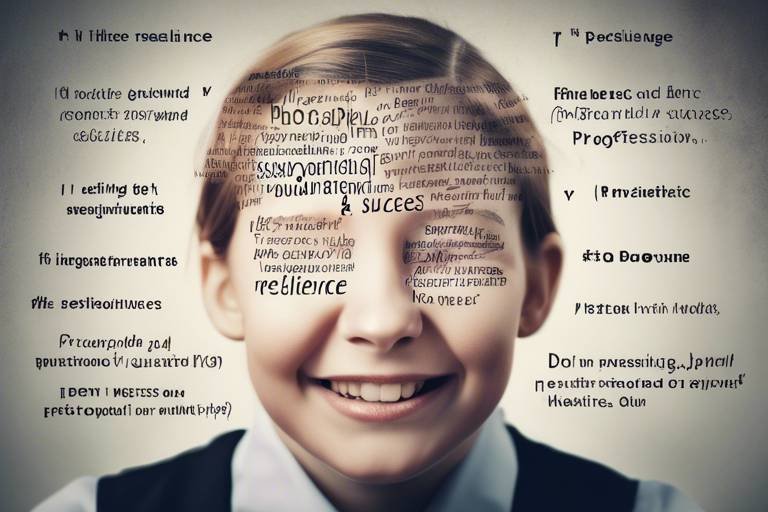Guide to Building Resilience in Children - Ensuring a Promising Future
This article explores effective strategies and practices to foster resilience in children, helping them navigate challenges and build a promising future. Resilience is not just a buzzword; it’s a vital skill that can shape a child’s ability to cope with life's ups and downs. Imagine resilience as a sturdy tree that bends in the wind but doesn’t break. This guide will take you through the essential elements that contribute to building this strength in our kids.
Resilience is the ability to bounce back from adversity, and it plays a crucial role in a child's emotional and mental health. When children encounter challenges—be it academic stress, social issues, or family dynamics—resilience helps them to not only recover but thrive. Think of resilience as a muscle; the more you exercise it, the stronger it gets. By understanding resilience, we can better support our children in developing this essential trait.
Several factors contribute to a child's resilience, including family dynamics, social support, and individual temperament. Each child is unique, and their resilience is shaped by a combination of these elements. For instance, a supportive family can act as a buffer against life's challenges, while a child's temperament can influence how they respond to stress. Let’s dive deeper into these influences.
The family unit is often the first place where children learn about resilience. A supportive home environment can provide the foundation for children to develop the skills they need to face challenges. Parents who practice effective parenting techniques can create a nurturing atmosphere that encourages open dialogue and emotional expression. This kind of environment fosters trust and security, allowing children to feel safe in sharing their fears and concerns.
Open communication within the family fosters trust and security. Encouraging dialogue between parents and children can be as simple as making time for daily conversations. Ask your child about their day, listen actively, and validate their feelings. This not only strengthens the parent-child bond but also teaches children that it’s okay to express their emotions. Consider these strategies:
- Make family meals a time for sharing experiences.
- Establish a "no-device" rule during conversations to ensure full attention.
- Encourage children to share their thoughts and feelings without judgment.
Children learn by example, and parents can model resilient behaviors and attitudes. When faced with challenges, how do you respond? Do you tackle problems head-on, or do you shy away? By demonstrating a positive attitude towards adversity, you can inspire your children to adopt similar approaches. Share your experiences with them, discussing both your struggles and how you overcame them. This not only teaches resilience but also builds a stronger connection between you and your child.
Social networks significantly affect a child's resilience. Friends, teachers, and community members provide essential support systems. A child who feels connected to others is more likely to develop resilience. Encourage your child to build friendships, participate in group activities, and engage with their community. These social interactions offer opportunities for collaboration, problem-solving, and emotional support, all of which contribute to resilience.
Equipping children with coping skills is vital for resilience. Coping skills are like tools in a toolbox; the more tools you have, the better prepared you are to handle various situations. Practical techniques and activities can help children manage stress effectively. For example, teaching them how to identify their feelings and express them appropriately can make a significant difference in how they cope with challenges.
Teaching children how to approach problems methodically enhances their resilience. Problem-solving is a skill that can be developed over time. Start by breaking down challenges into manageable parts and guiding your child through the process of finding solutions. Encourage them to think critically and creatively, and celebrate their efforts regardless of the outcome. This not only builds resilience but also enhances their confidence in handling future challenges.
Mindfulness can improve emotional regulation and focus. Introducing mindfulness exercises into your child's daily routine can help them stay grounded and calm in stressful situations. Simple practices like deep breathing, meditation, or even nature walks can make a world of difference. Encourage your child to take a few moments each day to reflect and breathe, helping them to build a strong foundation for emotional resilience.
A growth mindset fosters resilience by encouraging children to view challenges as opportunities for growth. Instead of fearing failure, children with a growth mindset see it as a stepping stone to success. This perspective can be cultivated through positive reinforcement and constructive feedback. Help your child understand that effort is just as important as achievement, and celebrate their willingness to try new things.
Goal-setting helps children develop a sense of purpose. When children set achievable and meaningful goals, they learn to work towards something, which can be incredibly motivating. Guide your child in setting realistic goals by breaking them down into smaller, actionable steps. This method not only makes big tasks more manageable but also allows for frequent celebrations of progress, reinforcing their resilience.
Recognizing children's efforts reinforces their resilience. Celebrate both small and big achievements to boost their confidence. Whether it’s completing a difficult homework assignment or showing kindness to a friend, acknowledging these moments can motivate children to continue striving for success. Remember, it’s not just about the end result; the journey matters too!
Q: What is resilience?
A: Resilience is the ability to bounce back from challenges and adversity, helping individuals cope with stress and overcome difficulties.
Q: How can I help my child build resilience?
A: You can support your child by creating a nurturing environment, teaching coping skills, and encouraging open communication.
Q: What role does social support play in resilience?
A: Social support from friends, family, and community members provides children with emotional backing and helps them feel connected, which is crucial for resilience.

Understanding Resilience
Resilience is not just a buzzword; it’s a fundamental quality that allows individuals, especially children, to navigate the often turbulent waters of life. Think of resilience as a rubber band; when stretched, it can bounce back to its original shape. This ability to recover from setbacks, adapt to change, and keep moving forward is crucial for emotional and mental well-being. Children face various challenges, from academic pressures to social dynamics, and resilience equips them with the tools they need to overcome these hurdles and emerge stronger.
So, why is resilience so important? Well, studies have shown that resilient children are more likely to cope effectively with stress, maintain better relationships, and achieve academic success. They possess a strong sense of self-worth and are often more optimistic about the future. This positive outlook can significantly influence their overall mental health, reducing the risk of anxiety and depression. In essence, fostering resilience in children is like giving them a sturdy umbrella to weather life’s storms.
But how do we define resilience in a practical sense? It encompasses several key components, including:
- Emotional regulation: The ability to manage emotions effectively, especially during stressful situations.
- Social competence: Skills that enable children to interact positively with others, forming healthy relationships.
- Problem-solving skills: The capacity to approach challenges with a constructive mindset, seeking solutions rather than dwelling on problems.
- Self-efficacy: A belief in one’s ability to succeed, which fosters motivation and persistence.
Understanding these components helps parents and caregivers identify areas where they can support their children. For instance, if a child struggles with emotional regulation, parents can introduce techniques like deep breathing or journaling to help them express their feelings more constructively. Likewise, encouraging social interactions can enhance a child's social competence, providing them with a solid foundation for building relationships.
In summary, resilience is a multifaceted trait that plays a vital role in a child's development. By nurturing this quality, we empower children to face challenges head-on, learn from their experiences, and ultimately thrive in an ever-changing world. It’s a journey that requires patience, understanding, and consistent support from the adults in their lives. So, let’s dig deeper into the factors that influence resilience and how we can actively foster this essential quality in our children.

Factors Influencing Resilience
Resilience isn't just a magical trait that some children possess; it's a complex interplay of various factors that shape how they respond to life's challenges. Understanding these factors is crucial for parents, educators, and caregivers who want to nurture resilience in children. So, what exactly influences a child's ability to bounce back from adversity? Let's dive into the key elements that contribute to building resilience.
First and foremost, family dynamics play a pivotal role. The environment in which a child grows up can either fortify their resilience or hinder it. A supportive home, where love and understanding flourish, can serve as a strong foundation. Think of it as a warm blanket on a cold night; it provides comfort and security. On the flip side, a chaotic household may leave children feeling insecure and anxious, which can stifle their ability to cope with stress.
Next, social support is another significant influence. Children thrive when they have a network of friends, teachers, and community members who provide encouragement and guidance. Imagine resilience as a tree; the stronger the roots (social support), the taller and sturdier the tree can grow. When kids face challenges, having a reliable support system can make a world of difference. They learn that they are not alone in their struggles and that it's okay to seek help when needed.
Individual temperament also plays a critical role in resilience. Each child is born with unique personality traits that can either enhance or hinder their ability to cope with difficulties. For instance, some children may naturally be more optimistic and adaptable, while others might be more sensitive or anxious. Understanding a child's temperament can help parents tailor their approach to fostering resilience. It's like customizing a recipe; the right ingredients can create a delicious outcome.
To summarize, here are the three primary factors influencing resilience:
- Family Dynamics: A nurturing environment promotes resilience.
- Social Support: A strong network of friends and mentors bolsters a child's ability to cope.
- Individual Temperament: Each child's unique personality traits can either facilitate or challenge their resilience.
By recognizing and addressing these factors, we can create an ecosystem that supports children in developing the resilience they need to navigate life's ups and downs. After all, resilience is not just about bouncing back; it's about thriving in the face of adversity.

The Role of Family
When it comes to building resilience in children, the family is the bedrock upon which everything else is built. Think of the family as a sturdy tree; the roots provide stability, nourishment, and support, allowing the branches to reach for the sky. In a supportive home environment, children feel secure and valued, which fosters a sense of belonging and confidence. This sense of security is crucial because it empowers children to face challenges head-on. So, how can families create this nurturing environment?
First and foremost, effective communication is essential. When family members engage in open and honest conversations, they build trust and understanding. Imagine a child coming home after a tough day at school; if they know they can talk to their parents without fear of judgment, they are more likely to express their feelings and seek guidance. Parents can encourage dialogue by:
- Asking open-ended questions that require more than a yes or no answer.
- Listening actively without interrupting, showing that their thoughts and feelings are valued.
- Creating a safe space where children can share their thoughts without fear of punishment.
Moreover, modeling resilience is another powerful way families can help children develop this vital skill. Children are like sponges; they absorb behaviors and attitudes from the adults around them. When parents face challenges with a positive attitude and demonstrate problem-solving skills, children learn to emulate these behaviors. For instance, if a parent encounters a setback at work but remains calm and seeks solutions, the child observes this resilience and learns to approach their own challenges similarly. This modeling can be as simple as discussing how to cope with stress or sharing stories of overcoming obstacles.
Additionally, family dynamics play a significant role in shaping resilience. A family that celebrates achievements, both big and small, cultivates an atmosphere of encouragement. This positive reinforcement helps children understand that effort is just as important as the outcome. For example, when a child receives praise for trying hard on a school project, they learn that perseverance is valued, which can motivate them to tackle future challenges with a resilient mindset.
Finally, it’s essential to remember that every family is unique, and what works for one may not work for another. However, the core principles of support, effective communication, and modeling resilience remain constant. By fostering a nurturing family environment, parents can equip their children with the tools they need to navigate life's ups and downs. After all, resilience is not just about bouncing back; it's about bouncing forward, and with a strong family foundation, children can soar to new heights.
- What is the most important factor in building resilience in children? While many factors contribute, a supportive family environment is often the most crucial element.
- How can I encourage my child to express their feelings? Create a safe space for open communication and model emotional expression yourself.
- Can resilience be taught? Absolutely! Through effective communication, modeling behaviors, and positive reinforcement, resilience can be nurtured in children.

Effective Communication
Effective communication within the family is the bedrock of building resilience in children. It’s not just about talking; it’s about creating a safe space where children feel comfortable expressing their thoughts and emotions. Imagine a cozy living room where everyone can share their day, their fears, and their dreams without fear of judgment. This kind of environment fosters trust and security, essential ingredients for emotional development. So, how can we cultivate such an atmosphere?
First, active listening is crucial. When children speak, they need to feel heard. This means putting down the phone, making eye contact, and showing genuine interest in what they are saying. Ask open-ended questions like, "How did that make you feel?" or "What do you think about that?" These questions encourage children to elaborate on their feelings and thoughts, helping them articulate their emotions more clearly. It’s like giving them the tools to paint their emotional landscapes, allowing them to express themselves vividly.
Moreover, it’s important to validate their feelings. If a child comes home upset about a friend not inviting them to a party, instead of dismissing it with “It’s not a big deal,” try saying, “I can see why you’d feel hurt. That sounds really tough.” This validation shows them that their feelings are important and worthy of discussion. It builds their emotional vocabulary and helps them understand that it’s okay to feel a range of emotions.
Another effective strategy is to encourage regular family meetings. These gatherings can be informal and can happen over dinner or during a weekend brunch. Use this time to discuss family issues, celebrate achievements, or even address any conflicts. It’s a wonderful way to practice communication skills in a structured, supportive environment. By doing so, children learn that it’s not only okay to express their feelings but also crucial for resolving issues and building stronger relationships.
Lastly, remember that modeling communication is vital. Children learn by observing their parents. If they see you communicating openly with your partner or friends, they’ll likely mimic that behavior. Share your own experiences and emotions, showing them that vulnerability is a strength, not a weakness. It’s like teaching them to ride a bike; they need to see you balance and pedal before they can do it themselves.
In summary, effective communication is a powerful tool in building resilience in children. By fostering an environment of active listening, validation, family discussions, and modeling positive communication, we equip our children with the skills they need to navigate life’s challenges. After all, the way we communicate shapes their understanding of relationships and their ability to cope with adversity. So, let’s make every conversation count!
- What is the best way to encourage children to express their feelings?
Encourage open dialogue by asking questions and showing genuine interest in their responses. Create a safe space where they feel comfortable sharing. - How can I improve my communication skills with my child?
Practice active listening, validate their feelings, and model effective communication in your interactions. - Are family meetings really effective?
Yes! They provide a structured way for everyone to share thoughts and feelings, fostering a sense of belonging and teamwork.

Modeling Resilience
When it comes to nurturing resilience in children, one of the most powerful tools at a parent's disposal is the ability to model resilient behavior. Children are like sponges, soaking up everything they observe in their environment, especially from their parents. If they see you facing challenges with a positive attitude, bouncing back from setbacks, and maintaining a sense of hope, they are more likely to adopt these behaviors themselves. It's not just about telling them to be strong; it's about showing them what strength looks like in real life.
Consider this: when you encounter a problem, do you throw your hands up in defeat, or do you take a moment to assess the situation and find a way forward? Children learn from these moments. For instance, if you face a tough day at work but come home and discuss it openly, explaining how you plan to tackle the issue, you are teaching your child the importance of perseverance and problem-solving. This modeling of behavior can significantly influence their emotional and mental development.
Here are a few effective strategies to model resilience:
- Share Your Experiences: Talk about your own challenges and how you overcame them. This not only humanizes you in their eyes but also provides them with real-life examples of resilience in action.
- Encourage a Positive Mindset: When things don’t go as planned, instead of focusing on the negative, emphasize what can be learned from the experience. Encourage your child to ask, “What can I do differently next time?”
- Demonstrate Emotional Regulation: Show them how to cope with emotions. If you're feeling frustrated, express it in a healthy way—maybe through deep breathing or talking it out—so they learn that it’s okay to feel upset, but it’s important to manage those feelings.
Furthermore, resilience is not just about bouncing back; it's also about growing from experiences. By showing your child that every setback is an opportunity for growth, you instill in them a sense of hope and determination. This can be as simple as discussing what went wrong in a school project and brainstorming ways to improve next time. It’s about creating a culture of learning and adaptation.
In essence, modeling resilience is about being a living example of how to navigate life's ups and downs. It’s about demonstrating that while life can be challenging, it is also filled with opportunities to learn and grow. By embodying these principles, you not only help your child develop their resilience but also strengthen your bond with them, creating a foundation of trust and support that will last a lifetime.
- What is resilience in children?
Resilience in children refers to their ability to adapt and recover from challenges, stress, and adversity, enabling them to cope with life's difficulties effectively. - How can I tell if my child is resilient?
Signs of resilience in children include a positive attitude, the ability to bounce back from setbacks, problem-solving skills, and the capability to manage emotions effectively. - What role does a parent play in building resilience?
Parents can build resilience by modeling positive behaviors, encouraging open communication, and providing a supportive environment where children feel safe to express their feelings and take risks.

The Impact of Social Support
When it comes to building resilience in children, social support is like the wind beneath their wings. Imagine a young tree swaying in the breeze; it needs the surrounding forest to shield it from harsh winds and provide nutrients. Similarly, children thrive when they have a robust network of friends, family, and mentors who can offer guidance and encouragement during tough times. Social support not only helps children cope with stress but also enhances their emotional well-being, making them feel valued and understood. A strong support system can be the difference between a child who crumbles under pressure and one who learns to stand tall.
Research shows that children with supportive relationships are more likely to develop a positive self-image and exhibit better emotional regulation. Think of it as a safety net; when children know they have people to turn to, they are more willing to take risks and face challenges head-on. This support can come from various sources, including:
- Family Members: Parents, siblings, and extended family can provide emotional backing and practical help.
- Friends: Peers offer companionship and shared experiences, which are vital during formative years.
- Teachers and Mentors: Educators can foster resilience by providing encouragement and recognizing children's efforts.
- Community Resources: Local organizations and clubs can also play a significant role in offering support and activities that promote social interaction.
It's essential to recognize that the quality of social support matters just as much as the quantity. A few close relationships can be more beneficial than a large network of acquaintances. Children who experience consistent, genuine support are better equipped to handle life's ups and downs. They learn that it's okay to ask for help, which is a critical lesson in resilience.
Moreover, fostering social support isn't just about being there during tough times; it’s also about celebrating successes together. When children share their achievements—big or small—they feel a sense of belonging and pride. This shared joy reinforces their self-esteem and encourages them to pursue their goals with vigor. In this way, social support creates a cycle of resilience, where each experience builds upon the last, creating a strong foundation for future challenges.
To sum it up, the impact of social support on a child's resilience cannot be overstated. It acts as a buffer against stress, nurtures emotional health, and cultivates a sense of community. Just like a sturdy tree stands tall in a supportive forest, children flourish when they are surrounded by caring individuals who believe in them. By actively fostering these relationships, we can help our children develop the resilience they need to navigate the complexities of life.
Q1: What is social support?
A1: Social support refers to the emotional, informational, and practical assistance provided by family, friends, and community. It plays a crucial role in helping individuals cope with stress and challenges.
Q2: How can parents encourage social support for their children?
A2: Parents can encourage social support by fostering open communication, promoting friendships, and engaging with community resources. Encouraging children to participate in group activities can also help build their social networks.
Q3: What are the signs that a child may lack social support?
A3: Signs may include feelings of loneliness, low self-esteem, withdrawal from social activities, and difficulty coping with stress. If a child seems isolated or struggles to form friendships, it may indicate a lack of social support.
Q4: Can social support impact a child's academic performance?
A4: Yes, children with strong social support often perform better academically. Supportive relationships can enhance motivation, reduce anxiety, and provide encouragement, all of which contribute to academic success.

Teaching Coping Skills
Equipping children with effective coping skills is crucial in helping them navigate the ups and downs of life. Just like a superhero needs a trusty toolkit to face villains, children also need a set of skills to tackle challenges and manage stress. Imagine facing a tough math test or dealing with a disagreement with a friend—having coping strategies can make all the difference in how they respond to these situations. This section outlines practical techniques and activities that can help children learn to manage stress effectively, setting them up for success in the future.
One of the most effective ways to teach coping skills is through role-playing scenarios. This technique allows children to practice responses to various stressors in a safe environment. For instance, you might set up a situation where a child has to deal with a bully or cope with losing a game. By acting out these scenarios, they can explore different ways to respond, helping them feel more prepared when faced with real-life challenges. It’s like rehearsing for a big performance—practice makes perfect!
Another valuable approach is to introduce deep breathing exercises. When children feel overwhelmed, their bodies can react in ways that heighten anxiety. Teaching them to take slow, deep breaths can help calm their minds and bodies. For example, you can encourage them to inhale deeply through their nose, hold for a few seconds, and then exhale slowly through their mouth. This simple technique can be a game-changer, acting as a reset button during stressful moments.
In addition to breathing exercises, incorporating mindfulness practices into daily routines can greatly enhance a child’s ability to cope with stress. Mindfulness encourages children to focus on the present moment, which can help reduce anxiety about future events. Activities such as guided imagery, where children visualize a peaceful place, or simple meditation practices can be introduced. These techniques not only help in managing stress but also improve concentration and emotional regulation.
Furthermore, teaching children to identify and express their feelings is essential. When children can articulate their emotions, they are better equipped to handle them. You might consider using a feelings chart that allows children to point out how they feel at any given moment. This visual aid can be a great conversation starter and can help parents understand what their children are experiencing. By normalizing discussions about emotions, you create an environment where children feel safe to express themselves.
Finally, it’s important to encourage children to develop a problem-solving mindset. Instead of viewing challenges as insurmountable obstacles, help them see these situations as opportunities for growth. Teach them to break down problems into manageable steps, which can make tackling them feel less daunting. For instance, if they’re struggling with homework, guide them to identify what specifically is difficult and brainstorm potential solutions together.
In summary, teaching coping skills to children is about providing them with the tools they need to handle life's challenges. By incorporating role-playing, deep breathing exercises, mindfulness practices, emotional expression, and problem-solving techniques into their daily lives, we can empower them to face adversity with confidence. Remember, every child is unique, so it’s essential to tailor these strategies to fit their individual needs. With the right support, they can build resilience and navigate their world more effectively.
- What are coping skills? Coping skills are strategies that help individuals manage stress and difficult emotions effectively.
- How can I teach my child coping skills? You can teach coping skills by modeling behavior, using role-play, and encouraging open discussions about feelings.
- Are mindfulness practices suitable for children? Yes, mindfulness practices can be adapted for children and can greatly benefit their emotional regulation and focus.
- What if my child struggles with expressing their emotions? Encourage them to use tools like feelings charts or art to express their emotions more comfortably.

Problem-Solving Strategies
Problem-solving is a vital skill that helps children navigate life's challenges effectively. When children learn to approach problems methodically, they not only develop resilience but also gain confidence in their ability to handle various situations. So, how can parents teach these essential skills? Let's explore some practical strategies that can be integrated into daily life.
First off, it's crucial to frame problems as opportunities for learning rather than as insurmountable obstacles. Encourage your child to view challenges through a positive lens. For instance, when faced with a difficult math problem, instead of saying, "I can't do this," they might say, "This is a chance to learn something new!" This shift in perspective can make a world of difference in how they tackle challenges.
One effective approach is to introduce a structured problem-solving process. Here’s a simple framework that can guide children through their challenges:
| Step | Description |
|---|---|
| 1. Identify the Problem | Help your child clearly define what the problem is. Ask questions like "What exactly is bothering you?" |
| 2. Brainstorm Solutions | Encourage them to think of as many solutions as possible, no matter how outlandish. This promotes creativity! |
| 3. Evaluate Options | Discuss the pros and cons of each solution. Which one seems most feasible? |
| 4. Implement a Solution | Guide them in taking action on the chosen solution. Remind them that taking the first step is crucial! |
| 5. Reflect on the Outcome | After the solution has been implemented, discuss what worked and what didn’t. Reflection solidifies learning. |
By utilizing this structured approach, children can learn not only how to solve problems but also how to become more independent thinkers. Additionally, it's important to celebrate their efforts throughout this process. When they successfully navigate a problem, big or small, acknowledge their hard work. This reinforcement helps to build their confidence and encourages them to face future challenges head-on.
Moreover, engaging in real-life scenarios can be incredibly beneficial. Consider involving your child in everyday decision-making processes, like planning a family outing or solving a household issue. This hands-on experience not only teaches them valuable problem-solving skills but also fosters a sense of responsibility and ownership.
Lastly, don't underestimate the power of asking guiding questions. Instead of providing direct answers, prompt your child with questions that lead them to find solutions on their own. Questions like “What do you think would happen if you tried this?” or “How do you feel about that option?” can stimulate critical thinking and encourage them to explore different possibilities.
In conclusion, teaching problem-solving strategies is an invaluable gift that parents can give their children. By equipping them with the tools to tackle challenges, you are not only fostering resilience but also preparing them for a future filled with opportunities and successes. Remember, every problem is a stepping stone to growth!
- What age should I start teaching problem-solving skills? It's beneficial to start as early as preschool, using simple scenarios and gradually increasing complexity as they grow.
- How can I encourage my child to be more independent in solving problems? Give them opportunities to make choices and decisions, and support them in reflecting on the outcomes.
- What if my child struggles with problem-solving? Encourage them to take a break and revisit the problem later, or help them break it down into smaller, more manageable parts.

Mindfulness Practices
In today's fast-paced world, teaching children mindfulness practices can be a game changer. Mindfulness is all about being present in the moment, and it can significantly enhance a child's emotional regulation and focus. Imagine your child navigating their busy day with a calm and centered approach, like a serene lake reflecting the clear sky above. Isn't that a beautiful image? By incorporating mindfulness into their daily routines, you can help them develop skills that will serve them well throughout their lives.
One effective way to introduce mindfulness is through simple breathing exercises. These exercises can be as easy as having your child take a few deep breaths, inhaling through the nose and exhaling slowly through the mouth. Encourage them to close their eyes and visualize a peaceful scene, like a beach or a forest. This not only calms their mind but also helps them learn to focus on their breath, which is a foundational aspect of mindfulness. Here’s a quick guide to a simple breathing exercise:
| Steps | Description |
|---|---|
| 1. Find a Quiet Space | Choose a calm environment free from distractions. |
| 2. Sit Comfortably | Have your child sit in a comfortable position with their back straight. |
| 3. Close Eyes | Encourage them to close their eyes gently. |
| 4. Breathe In | Instruct them to inhale deeply through the nose for a count of four. |
| 5. Hold and Exhale | Hold for a count of four, then exhale slowly through the mouth for a count of six. |
| 6. Repeat | Repeat this process for five minutes, gradually increasing the duration. |
Another engaging mindfulness practice is mindful observation. This can be done during a walk or even while sitting in the backyard. Encourage your child to observe their surroundings and describe what they see, hear, and feel. This practice not only enhances their awareness but also encourages them to appreciate the little things in life, like the rustling of leaves or the colors of flowers. It's like giving them a pair of special glasses that help them see the world in a whole new light!
Additionally, integrating mindfulness into daily activities can be both fun and effective. For example, during meal times, you can practice “mindful eating.” This means taking the time to savor each bite, noticing the flavors and textures of the food. You can ask your child questions like, “How does this taste?” or “What do you notice about the texture?” This not only promotes mindfulness but also encourages healthy eating habits.
Finally, consider using mindfulness apps or guided meditations designed for children. There are many resources available that offer engaging and age-appropriate content. These tools can make mindfulness practices feel less like a chore and more like an exciting adventure. Just like any new skill, the more they practice mindfulness, the more natural it will become for them. So, why not start today? Your child’s future self will thank you!
- What age is appropriate to start teaching mindfulness to children? Mindfulness can be introduced as early as preschool age, with simple exercises tailored to their developmental level.
- How long should mindfulness practices last? Start with short sessions of about 5-10 minutes, gradually increasing the duration as your child becomes more comfortable.
- Can mindfulness help with anxiety? Yes, studies have shown that mindfulness practices can reduce anxiety and improve emotional regulation in children.
- Are there specific mindfulness apps for kids? Absolutely! There are several apps designed specifically for children that include guided meditations and mindfulness exercises.

Encouraging a Growth Mindset
Encouraging a growth mindset in children is like giving them a superpower to tackle life's challenges head-on. When children believe that their abilities can improve with effort and persistence, they become more resilient. Imagine teaching them to view obstacles not as roadblocks but as stepping stones to success. This shift in perspective can profoundly influence their approach to learning and personal development. So, how do we, as parents and educators, cultivate this invaluable mindset in our young ones?
First off, it's essential to create an environment that celebrates effort over innate talent. When children hear phrases like, "Great job on trying that math problem!" instead of, "You're so smart!", they learn that hard work is what leads to success. This subtle change in language can have a significant impact on their self-esteem and motivation. It’s about instilling the belief that failure is just a part of the learning process. When they stumble, remind them that every mistake is an opportunity to grow. This helps them understand that resilience isn’t about never falling down; it’s about getting back up and trying again.
Another effective strategy is to encourage children to set realistic goals. When children have clear, achievable objectives, they can focus their efforts and see their progress over time. For instance, rather than saying, "I want to be the best at soccer," guide them to set specific goals like, "I want to practice dribbling for 15 minutes every day this week." This approach not only helps them hone their skills but also fosters a sense of accomplishment as they track their progress.
Additionally, fostering a culture of celebrating effort and achievements—big or small—is crucial. When children accomplish something, whether it’s mastering a new skill or simply completing their homework, take the time to acknowledge their hard work. This recognition reinforces their belief in their ability to grow and develop. You might even consider creating a "celebration board" at home or in the classroom where children can display their achievements. This visual representation of their efforts can serve as a constant reminder of their capabilities.
To further enhance this growth mindset, introduce children to stories of famous individuals who faced challenges and failures before achieving success. Discussing figures like Thomas Edison, who famously said, "I have not failed. I've just found 10,000 ways that won't work.", can inspire children to embrace their struggles and view them as part of their journey. Sharing these narratives helps them see that resilience is a common trait among successful people.
Lastly, integrating mindfulness practices can also support the development of a growth mindset. When children learn to stay present and manage their thoughts and emotions, they become better equipped to handle setbacks. Simple mindfulness exercises, such as deep breathing or guided imagery, can help them calm their minds and refocus when faced with challenges. This mental clarity allows them to approach problems with a fresh perspective and an open heart.
In summary, nurturing a growth mindset in children is all about creating an atmosphere that values effort, encourages realistic goal-setting, celebrates achievements, shares inspiring stories, and integrates mindfulness practices. By doing so, we equip them with the tools they need to face life's challenges with confidence and resilience.
- What is a growth mindset? A growth mindset is the belief that abilities and intelligence can be developed through dedication and hard work.
- How can I encourage a growth mindset at home? Use positive language that emphasizes effort, set achievable goals, celebrate successes, and share stories of perseverance.
- Why is a growth mindset important for children? It helps children become more resilient, encourages them to embrace challenges, and fosters a love for learning.

Setting Realistic Goals
Setting realistic goals is not just a task; it's an essential stepping stone in a child's journey toward resilience and success. When children learn to set achievable goals, they cultivate a sense of purpose and direction in their lives. Imagine a child standing at the base of a mountain, looking up at the peak. If they try to climb straight to the top without a plan, they might feel overwhelmed and discouraged. However, if they break the journey down into smaller, manageable steps, the climb suddenly seems possible. This analogy perfectly illustrates the importance of realistic goal-setting.
To help children set realistic goals, parents and caregivers should encourage them to think about what they truly want to achieve. This could range from academic aspirations, like improving a math grade, to personal goals, such as making new friends. The key is to ensure that these goals are specific, measurable, attainable, relevant, and time-bound—often referred to as the SMART criteria. For example, instead of saying, "I want to do better in school," a child might say, "I want to raise my math grade from a C to a B by the end of the semester." This clarity not only makes the goal more achievable but also instills a sense of accountability.
Additionally, it’s crucial to celebrate the process of setting and achieving these goals. When children experience success, no matter how small, it boosts their confidence and reinforces their belief in their abilities. Consider creating a visual chart or a goal tracker where children can mark off their progress. This visual representation serves as a constant reminder of their journey, making the process both engaging and rewarding.
Moreover, parents can facilitate discussions about the challenges that might arise while pursuing these goals. Encouraging children to anticipate obstacles and think of potential solutions fosters critical thinking and problem-solving skills. For instance, if a child’s goal is to complete a project on time, they should consider what resources they might need, how they will manage their time, and what to do if they encounter difficulties. This proactive approach not only enhances their resilience but also prepares them for future challenges.
In conclusion, setting realistic goals is a vital practice that empowers children to navigate their paths with confidence and resilience. By guiding them through the goal-setting process and celebrating their achievements, parents can help cultivate a growth mindset that will serve them well throughout their lives. Remember, it’s not just about reaching the destination; it’s about enjoying the journey and learning along the way.
- What are realistic goals for children? Realistic goals for children are specific, attainable objectives that can be achieved within a certain timeframe, allowing them to experience success and build confidence.
- How can I help my child set goals? You can help your child set goals by discussing their interests, using the SMART criteria, and encouraging them to think about the steps needed to achieve their goals.
- Why is celebrating achievements important? Celebrating achievements, no matter how small, reinforces a child's confidence and motivates them to continue pursuing their goals.
- What should I do if my child struggles to reach their goals? If your child struggles, encourage them to reflect on the challenges they faced and help them brainstorm solutions. Remind them that setbacks are a natural part of the learning process.

Celebrating Efforts and Achievements
Celebrating efforts and achievements is a pivotal aspect of nurturing resilience in children. It’s not just about the end result; it’s about recognizing the journey they take to get there. When children see that their hard work is acknowledged, it instills a sense of pride and encourages them to tackle future challenges head-on. Imagine a young athlete who trains tirelessly for a competition. If their efforts are celebrated, regardless of whether they win or lose, they are likely to develop a stronger drive to improve and persevere. This is the essence of resilience!
One effective way to celebrate achievements is through verbal recognition. Simple phrases like "I’m so proud of you!" or "You worked really hard on that!" can significantly boost a child's self-esteem. Additionally, parents and caregivers can create a celebration ritual that becomes a cherished family tradition. This could be as simple as a special dinner, a family outing, or even a homemade certificate of achievement. Such rituals not only reinforce the child’s accomplishments but also strengthen family bonds.
Incorporating visual reminders of achievements can also be beneficial. For instance, a dedicated wall or bulletin board displaying the child’s artwork, sports medals, or certificates can serve as a constant reminder of their capabilities. This not only boosts their confidence but also encourages them to strive for new goals. Remember, the more visible their achievements are, the more they will feel valued and motivated to continue striving for success.
Moreover, it’s essential to celebrate both small and large milestones. Whether it’s mastering a new skill, completing a challenging homework assignment, or simply showing kindness to a peer, every effort deserves recognition. Here’s a quick look at how to celebrate various achievements:
| Achievement Type | Celebration Ideas |
|---|---|
| Academic Success | Special dinner, sticker rewards, or a fun outing |
| Sports Milestone | Team celebration, personalized trophy, or a family picnic |
| Personal Growth | Handwritten notes of encouragement, a surprise treat, or a family movie night |
Ultimately, celebrating efforts and achievements is not just about the accolades; it’s about building a strong foundation of resilience in children. By fostering an environment where children feel appreciated for their hard work, we equip them with the confidence to face future challenges. They learn that it’s okay to stumble along the way, as long as they keep trying. In this way, we are not just celebrating their present; we are paving the way for a promising future where they can thrive, no matter what life throws at them.
- Why is celebrating small achievements important? Celebrating small achievements boosts a child's confidence and encourages them to continue striving for success.
- How can I effectively celebrate my child's achievements? You can celebrate by offering verbal praise, creating rituals, or giving visual reminders of their accomplishments.
- What types of achievements should be celebrated? Both small and large achievements should be celebrated, including academic success, personal growth, and sports milestones.
Frequently Asked Questions
-
What is resilience and why is it important for children?
Resilience is the ability to bounce back from challenges and adversity. It's crucial for children because it helps them navigate life's ups and downs, fostering emotional and mental well-being. When children develop resilience, they are better equipped to handle stress, setbacks, and failures, which ultimately leads to a more promising future.
-
How can family dynamics influence a child's resilience?
Family dynamics play a significant role in shaping a child's resilience. A supportive home environment, where open communication and trust are prioritized, helps children feel secure. When parents model resilient behaviors and attitudes, children are more likely to adopt these traits, creating a strong foundation for handling life's challenges.
-
What role does social support play in building resilience?
Social support is vital for children's resilience. Friends, teachers, and community members provide emotional backing and practical help when needed. A strong social network can enhance a child's ability to cope with difficulties, making them feel less isolated and more empowered to face challenges.
-
What are some effective coping skills I can teach my child?
Teaching coping skills can significantly boost your child's resilience. Some effective techniques include problem-solving strategies, where children learn to approach issues methodically, and mindfulness practices that help them regulate emotions and focus better. Incorporating these skills into daily routines can make a big difference.
-
How can I encourage a growth mindset in my child?
Encouraging a growth mindset involves teaching children to view challenges as opportunities for growth. You can do this by guiding them in setting realistic goals and celebrating their efforts and achievements, no matter how small. This reinforcement builds their confidence and encourages them to embrace challenges with a positive outlook.



















